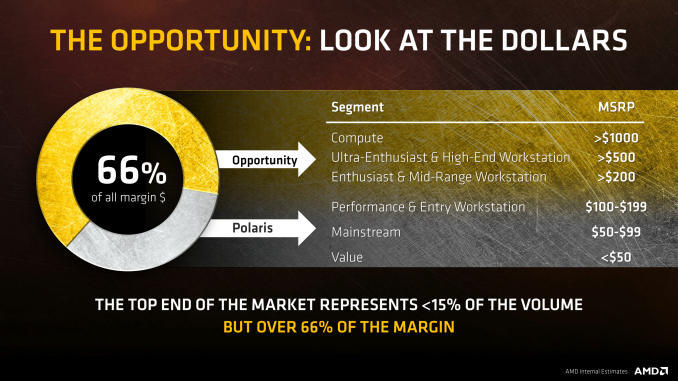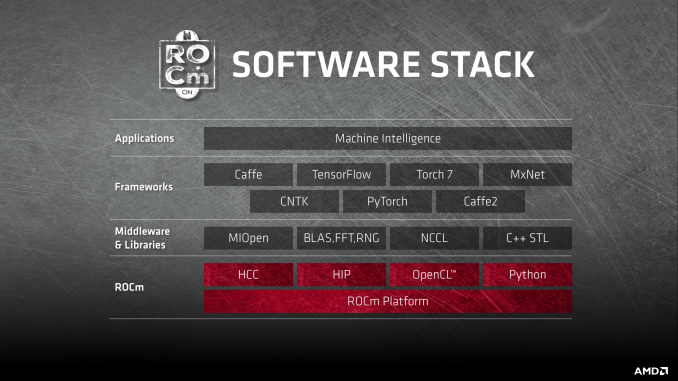AMD Unveils the Radeon Vega Frontier Edition: Vega Starts in the Pros
by Ryan Smith on May 17, 2017 2:45 AM EST- Posted in
- GPUs
- AMD
- Radeon
- Machine Learning
- Vega
- Radeon Pro
- Vega Frontier Edition
Vega Frontier Edition’s Target Market: AI, Machine Learning, and other Professionals
As important as the Vega hardware itself is, for AMD the target market for the hardware is equally important if not more. Vega’s the first new high-end GPU from the company in two years, and it comes at a time when GPU sales are booming.
Advances in machine learning have made GPUs the hottest computational peripheral since the x87 floating point co-processor, and unfortunately for AMD, they’ve largely missed the boat on this. Competitor NVIDIA has vastly grown their datacenter business over just the last year on the back of machine learning, thanks in large part to the task-optimized capabilities of the Pascal architecture. And most importantly of all, these machine learning accelerators have been highly profitable, fetching high margins even when the cards are readily available.
For AMD then, Vega is their chance to finally break into the machine learning market in a big way. The GPU isn’t just a high-end competitor, but it offers high performance FP16 and INT8 modes that earlier AMD GPU architectures lacked, and those modes are in turn immensely beneficial to machine learning performance. As a result, for the Vega Frontier Edition launch, AMD is taking a page from the NVIDIA playbook: rather than starting off the Vega generation with consumer cards, they’re going to launch with professional cards for the workstation market.
To be sure, the Radeon Vega Frontier Edition is not officially branded as a Pro or WX series card. But in terms of AMD’s target market, it’s unambiguously a professional card. The product page is hosted on the pro graphics section of AMD’s website, the marketing material is all about professional uses, and AMD even goes so far as to tell gamers to hold off for cheaper gaming cards later on in their official blog post. Consequently the Vega FE is about the closest analogue AMD has to NVIDIA’s Titan series cards, which although are gaming capable, in the last generation they have become almost exclusively professional focused.
AMD launching a new GPU architecture in the professional space first is a very big deal. Simply put, the company has never done it before. Fiji, Hawaii, Tahiti, Cayman, Cypress, and more all launched in consumer cards first. The traditional wisdom here is that launching in the consumer space first allows consumers to get their hands on the cards now, while professional products undergo further validation and refinement to meet the higher standards of professional users. Put another way, consumers serve as the final layer of debugging a new GPU, offering mass testing unlike anything else. So for AMD to launch in the pro market first indicates that they have an extensive amount of faith in the product.
As for why AMD would want to do this, the following AMD slide says it all.
Simply put, professional cards sell for higher prices than consumer gaming cards, sometimes significantly higher. As a result it makes all the sense in the world to sell their first Vega cards to professional users who are willing to pay $1000+ for a compute card, as opposed to consumers who would like to pay half that. More than anything else, AMD’s overall lack of profitability has come from a lack of high-margin parts to help offset their ongoing operational costs, and launching Vega as a pro card is one of the steps AMD is taking to correct that.
For pro users then with sufficiently deep pockets, they’ll be the first to get a crack at AMD’s latest high-end video card/accelerator. AMD calls this line of cards the Frontier Edition, and while the name is clearly AMD being cheeky towards NVIDIA’s Founder’s Edition line, the analogy isn’t completely off-base. AMD’s target market is going to be machine learning developers, game developers, and others who AMD believes need early access to the cards for future development. The advantage of this route is that, particularly in the case of machine learning, this allows developers to get a jump on testing a new architecture ahead of placing a large order for server cards. So in a sense, one of the roles of the Vega FE is to prime the pump for selling Radeon Instinct MI25 cards later in the year.
As for consumers, while this is as big a change for them as it is for AMD, it’s likely a hallmark of what to expect in the future for new high-end GPU launches. For AMD gamers who have been holding out for Vega, it’s clear that they’ll have to hold out a bit longer. AMD is developing traditional consumer gaming cards as well, but by asking gamers to hold off a little while longer when the Vega FE already isn’t launching until late June, AMD is signaling that we shouldn’t be expecting consumer cards until the second half of the year.
Wrapping things up, it’ll be very interesting to see how this strategy goes for AMD. NVIDIA has been very successful in the machine learning market over the last year, and if AMD can replicate NVIDIA’s success, not only will they make the machine learning market far more competitive for everyone, but they also stand a very good chance of finally turning the corner on both profitability and their overall share of the HPC market.













134 Comments
View All Comments
vladx - Wednesday, May 17, 2017 - link
Indeed, RX 480 with 5.8 TFLOPs is about equal to 1060 GT with 3.9 TFLOPs so we need to see how much improved Vega really is.juliovillaz1990 - Wednesday, May 17, 2017 - link
You are wrong.. the 1060 its 5 tflops aproximately. You're nota taking un consideration the auto oc feature of Pascal cards, the 1060 auto overclocks nearly 2000mhz si its not 3.9 tflopsYojimbo - Thursday, May 18, 2017 - link
Where do you get this from? In what games is the GTX 1060 averaging 2000 MHz without overclocking?Regardless, it doesn't matter. You are agreeing that AMD's listed TFLOPs are worth less than NVIDIA's listed TFLOPs, which was the point of the thread. Whether it's true because NVIDIA's cards are able to consistently clock above their listed frequencies or because NVIDIA's architecture spends less time waiting around doesn't matter. (As long as NVIDIA's cards stay within their thermal envelopes, which they seem to do better than AMD's, in fact.)
Alexvrb - Sunday, May 21, 2017 - link
Gaming performance isn't the best measure when talking about professional graphics cards. It's silly to say "X TFLOPS on card A equals Y TFLOPS on card B because of gaming benchmarks" when discussing professional cards that are used for different software.vladx - Monday, May 22, 2017 - link
Don't know who you're responding to, I compared RX 480 and 1060 GT which neither being part of pro segment and I specifically mentioned we need a better picture of Vega's architecture.Yojimbo - Monday, May 22, 2017 - link
"Gaming performance isn't the best measure when talking about professional graphics cards. It's silly to say "X TFLOPS on card A equals Y TFLOPS on card B because of gaming benchmarks" when discussing professional cards that are used for different software."I think vladx's use of gaming performance to demonstrate that TFLOPs cannot be used to directly compare performance between two different architectures is perfectly fine. The person he replied to performed just such a comparison. And although vladx did say that Vega has to improve for AMD to catch up to NVIDIA, and perhaps that's not true in professional applications (I don't really know), the original post should not be assumed to be about professional performance. The OP simply said "I really want Vega to succeed", not "I really want this Vega Frontier Edition to succeed". I'm guessing he meant Vega in all its incarnations.
extide - Thursday, May 18, 2017 - link
When it comes to actual FLOPs ... FLOPS are FLOPS, they are the same. When it comes to how FLOPS translate to gaming performance .. that's another discussion, yes.CiccioB - Thursday, May 18, 2017 - link
No, and no.A TFLOPS means nothing at all. Because and operation is not like another.
We are used to FMA OPS to calculate theoretical peak TFLOPS capacities, but those do not really mean nothing. How many FMA do you use in an algorithm? How long can you sustain many FMA one after the other before bandwidth do fed them becomes a bottleneck?
A TFLOPS is not a precise unit of measure. It's just a "standard" way to classify computing devices. It may be that my device can't do FMA in a single cycle, so having half of your teorethica computational peak, but I may go faster than you.
So again a TFLOPS means nothing. What it really counts is the efficiency at which the architecture execute complex algorithms (and that is before you tale into account other resources like ROPS or TMUs or geometric management for a 3D pipeline).
By what we have seen today, nvidia is way more efficient than AMD in both area/perfomance and w/performance.
fanofanand - Wednesday, May 24, 2017 - link
Nvidia is using a bigger die to get similar numbers. Not sure where the area/performance you speak of stems from. AMD appears to be cheaper in a $/performance and area/performance comparison with Nvidia's latest and greatest design. I'm sure someone will correct me if I'm wrong, but the new Nvidia die is at the TSMC reticle limit.frenchy_2001 - Wednesday, May 24, 2017 - link
If you're talking about Volta, you're right, it is a much bigger die. What it is NOT though, is a competitor for this card. This Vega boasts 13TFlops, Volta boasts 120TFlops per chip for DNN (FP16 matrix multiply/add). It will also sell for a much higher price (Volta mezzanine cards are around $16k each). This is like comparing a Formula1 car and a Lexus. Not the same usage or market.This is supposed to compete with Titan XP. In that comparison, AMD uses much more expensive RAM (HBM2 vs GDDR5X) and die size is so far undisclosed, but past chips size and power consumption have not been in AMD's favor.